
The John L. Dart Library at 1067 King Street bears the name of a pioneering figure in the history of education in Charleston. Born free during the last years of slavery, Dart benefited from the first flowering of African-American schools after the Civil War. He returned home in 1886 as a Baptist minister and devoted the rest of his life to the creation of free schools providing practical vocational training to African-American children. Undeterred by racial prejudice and professional controversy, Rev. Dart persevered to make a lasting cultural contribution to the Palmetto City.
John Lewis Dart was born on 10 March 1854 to Susan Fenwick (died 1882) and William Dart (died 1875), “free people of color” residing within the City of Charleston. Little is known of John’s early life except that his father, a painter, and his mother, a seamstress, purchased a lot in 1853 and built a home on the east side of Coming Street. This house, located slightly north of Bogard Street, was likely the birthplace of John Dart.[1] At the conclusion of the American Civil War in 1865, when John was eleven years old, his father, William, became the chief deacon of a newly-formed Baptist congregation that erected a church on the south side of Morris Street, midway between Coming and St. Philip Street. The Morris Street Baptist Church, incorporated in 1870, served an important role in the Baptist community in the Lowcountry of South Carolina and spawned a number of other churches in the later years of the nineteenth century.[2]
As a teenager, John Dart attend Charleston’s prestigious Avery Normal Institute, where he was valedictorian of his high-school class in 1872. He then spent two years teaching in small schools in Sumter, South Carolina, and saving money to further his education. With financial assistance from “friends at the North,” Dart completed a baccalaureate degree at Atlanta University in 1879. He then pursed a three-year course at Newton Theological Institution in Massachusetts, graduating in 1882 and becoming an ordained Baptist minister. Later the same year, he completed a Master of Arts degree at Atlanta University and commenced his professional career.[3]

Young Reverend Dart spent two years teaching in Washington, D.C., then one year as pastor of a Baptist Church in Providence, Rhode Island, before taking charge of a congregation in Augusta, Georgia. Following the death of Rev. Jacob Legare, first pastor of Charleston’s Morris Street Baptist Church, in October 1885, the congregation called John Dart to return home to the church his father had helped established twenty years earlier. His pastorate commenced in July 1886, less than two months before the city experienced a devastating earthquake. The Morris Street Baptist Church suffered minimal damage during the quake, but the shock retarded the pace of cultural and educational progress in the city for years to come.
In the several decades following the Civil War and the demise of slavery, Charleston’s municipal school board spent the bulk of the city’s educational budget constructing and maintaining various facilities for white pupils who formed the minority of the community’s juvenile population, while there were just two ramshackle public schools for African-American children—the Shaw Memorial School on Mary Street and an un-named school at the southwest end of Morris Street that later became known as the Simonton School—both staffed by white teachers. A handful of private schools offered elementary education to Black children within the city, but school attendance in South Carolina did not become compulsory until 1919. As a result of these factors, thousands of African-American children in late-nineteenth-century Charleston received little or no formal education. Poverty, crime, and exploitation were facts of life on the urban streets that citizens Black and white decried loudly while the rise of Jim Crow laws deepened the chasm of racial disparity in South Carolina.
At some point in 1886, perhaps shortly after John Dart’s return to Charleston, the Morris Street Baptist Church launched a small private school of its own. In contrast to the liberal arts education Dart had enjoyed during his youth, the pastor of the Morris Street church nurtured a small institution that focused on teaching rudimentary reading, writing, and arithmetic as well as providing “industrial” or vocational training to Black children. Little is known about the school’s early days, but a review of its work in July 1893 stated that the “Industrial School connected with that church . . . has been doing a quiet but successful work in this city during the past seven years, has an enrolment of one hundred and twenty girls and boys this year, with an average attendance of ninety. On account of limited means and space[,] the efforts of the school have been narrowed and confined to the lines of sewing, making fancy articles and kindergarten and moral training.” The school had three teachers, all black women, whose salaries were funded by the Women’s Home Mission Society of Chicago. Under the supervision of Rev. Dart, the school charged no tuition and was open to all Black children, regardless of religious affiliation.[4]
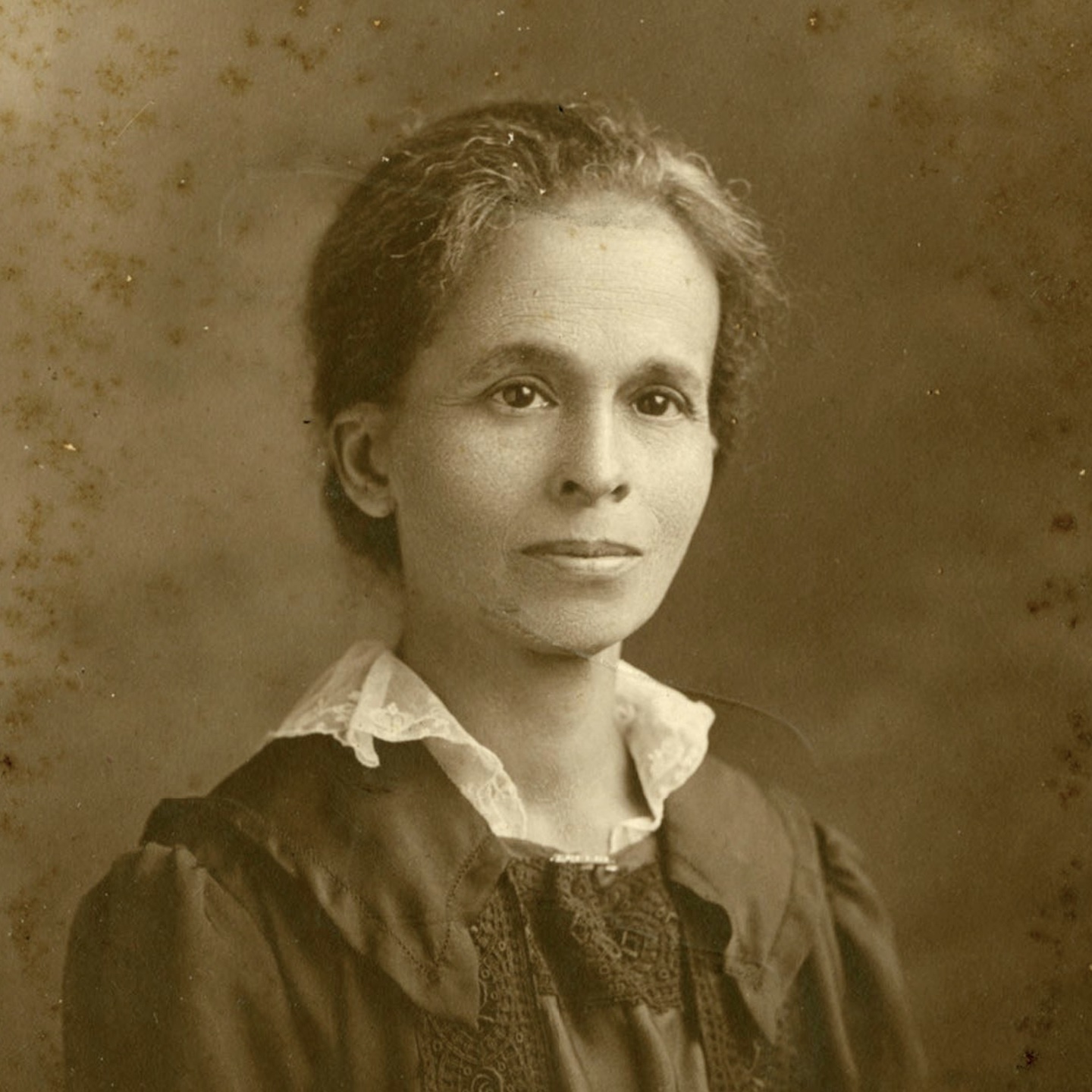
Dart’s passion for education led him back to Washington D.C. in 1887, where he married a public school teacher named Julia A. Pierre (1865–1952), whom he had met while working in that city several years earlier. The couple settled into the Morris Street parsonage in Charleston and eventually welcomed four children: Susan Dart Butler (1888–1959), William Andrews Dart, Anna Pierre Dart Bronseaux (1896–1978), and John Lewis Dart Jr. (1908–1922).
By 1889, Rev. Dart was a confident thirty-five-year-old family man with a growing professional reputation within Charleston’s vibrant African-American religious community. That summer, for example, he flexed his professional prowess by challenging Black ministers of other denominations in a debate on the spiritually proper and historically accurate method of baptism.[5] The fruits of his challenge are unknown, but the exercise demonstrated both an authoritative spirit and a penchant for confrontation. Such traits led to a schism within the congregation of Morris Street Baptist Church in the autumn of 1890, when a portion of the members sought to excommunicate their strong-willed pastor.[6] The well-publicized controversy subsided for a period of months, but then rekindled in the autumn of 1891.[7] Heated exchanges in church and a police presence during services in late 1892 were not resolved until the spring of 1893, during which time a number of “Anti-Dart” congregants defected to other Baptist churches in the city.[8] In the interest of time, and in fairness to the good reverend’s legacy, I’ll pass over these turbulent events and continue narrating his educational activities.
In the early spring of 1893, the people of Charleston learned that a local businessman, John Thomson, had left a sizeable bequest estimated at more than $100,000 to the city government. Citizens from all walks of life filled the columns of local newspapers with suggested uses for the money, several of which concerned schools of various descriptions. Rev. Dart was among the contributors in early April, describing himself as a “humble taxpayer” with an honest opinion: “Let the city provide, by all means, a public school building down-town for colored children, which is most sadly needed and for which the colored people have been petitioning the school commissioners for some years. . . . Humanity demands that we take some step to keep the many boys and girls that are running wild in this city, and are growing up to recruit the criminal classes, out of the chain gang, jail and penitentiary.”[9] City officials ignored Dart’s suggestion, however, choosing instead to build a large auditorium on Rutledge Avenue for the 1899 Confederate Reunion, which afterwards became the home of the Charleston Museum.
At that same moment in the spring of 1893, agents of the John F. Slater Fund for the Education of Freedmen in New York expressed an interest in funding the construction of a large industrial school for African-American children somewhere in the South. White members of the Charleston Chamber of Commerce assembled to discuss the issue on April 11th, joined by two Black ministers, Rev. John Dart and Rev. George C. Rowe. The group agreed that an industrial school was badly needed in urban Charleston, and crafted a telegram inviting agents of the Slater fund to consider the Palmetto City in their deliberations.[10] Although the proposed industrial school did not come to Charleston, Dart’s interaction with prominent white Charlestonians in April 1893 seems to have catalyzed his educational zeal and inspired him to push forward on his own.
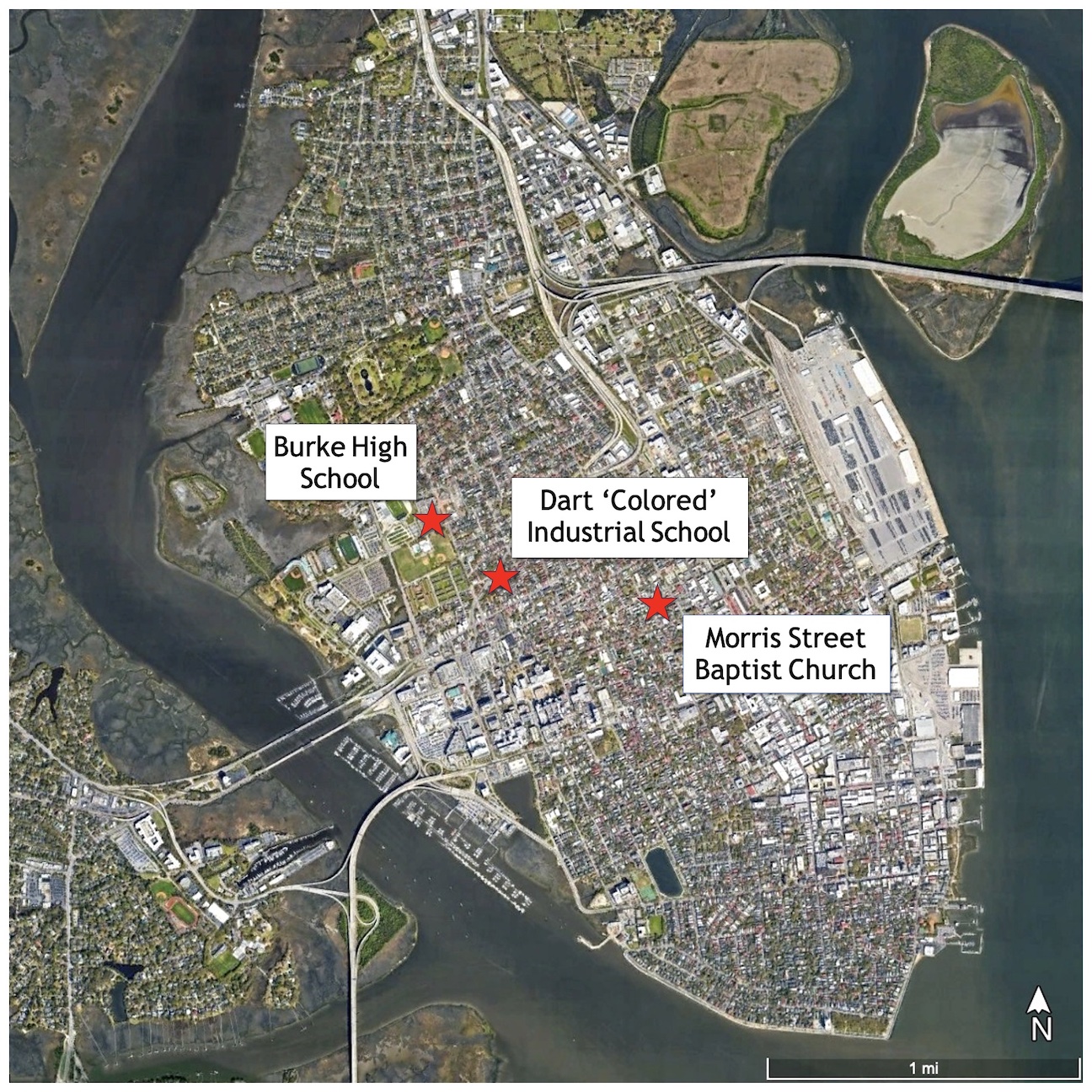
The small, privately-funded industrial school associated with Morris Street Baptist Church garnered a modicum of publicity in the summer of 1893 as locals considered how to educate the city’s African-American children with the least expense to taxpayers. The Charleston News and Courier described Rev. Dart’s modest institution as a “model school” that July, while the Reverend Daniel Jenkins (ca. 1862–1937) lobbied City Council to open a similar school and orphanage in the disused Marine Hospital building on the east side of Franklin Street. The Jenkins campaign succeeded in the autumn of the 1893, and his eponymous orphanage and modest industrial school became an immortal fixture in the history of Charleston.[11] After a summer trip to Northern cities, Rev. Dart launched a vigorous campaign to expand his existing educational work. While Rev. Jenkins tried to care for Black youth living in the southern part of the peninsular city, Dart announced his intention to create a new industrial school in the upper wards of Charleston, somewhere north of Sheppard Street. In October 1893, Rev. Dart explained his reasons for pushing for the creation of a private industrial school. His remarks perhaps reflected a bit of his own experience, as the child of skilled laborers who steered their son into the acquisition of a classical, liberal-arts education.
“Heretofore a very large part of the education given the advanced colored youth in the South has been misdirected and has been on wrong lines. It has caused them to take a false view of life and has unfitted them for the practical and useful work and stern duties of life. The uncalled for amount of Greek, Latin, metaphysics and higher mathematics that has been crammed into the minds of most colored youth during the last two decades has had the effect of overcrowding and overrunning the learned professions with college bred graduates who are disqualified to improve and advance the real material and industrial condition of the great masses of the Negro race in the South.
The colleges and universities of the South spoiled many of the Negro youth, and rendered them of little or no use to the race when they were classically and professionally educated and forced into the ministry, the legal and medical professions and college professorships, instead of following their natural aptitudes and becoming skilled mechanics and artisans, scientific farmers and workmen, and practical businessmen.
The gospel of manual training must be taught [to] the colored boys and girls if the race, in future, is to take a high and honorable position in the great march of industrial progress in this country. They must be schooled into the knowledge that labor is honorable, dignified and the source of prosperity and happiness.”[12]

Dart and his like-minded colleagues, mostly Black preachers drawn from the churches of urban Charleston, spent the later part of 1893 and the first half of 1894 raising money to launch a larger, non-denominational institution offering a more extensive curriculum of elementary education and vocational training.[13] By June 1894, they had negotiated a plan to purchase land on the west side of Kracke Street in Charleston, immediately south of Bogard Street, for the erection of several school buildings for Black boys and girls living in the city’s upper wards. By the end of July, Dart confidently predicted that the school would open in the autumn of 1894. The ceremony for the laying of the cornerstone of the first building took place slightly later than predicted, on September 24th. Fundraising and construction continued through the remainder of the year, and the Charleston Industrial School, as it was initially called, opened its doors on 3 January 1895.[14]
The school’s first structure, a two-story, rectangular, wooden-frame building, housed a kindergarten as well as classrooms for boys and girls, augmented by a neighboring one-story structure used as a workshop for manual trades. A newspaper review of the students’ closing exercises in June 1895 described Dart’s novel institution as the only school of its kind in Charleston, where the city’s two public schools for Black children could not possibly accommodate the community’s large population.[15] In May 1896, near the end of the industrial school’s second year, Principal Dart summarized his general educational goal by stating that he sought to transform African-American youth into self-sufficient adults that would become a credit to their community.[16] A review published in June 1897 offered a more substantive overview of its mission:
“About three years ago a few leading and responsible colored men of this city, headed by the Rev. J. L. Dart, came together and decided to establish here an industrial and manual training school, where some of the many Negro boys and girls in this city that are growing up in ignorance, crime and idleness might be given a plain English education and be taught useful trades and how to do good and skillful work with their hands. The projectors of this school have always believed that the surest way to help in the elevation of the more than thirty thousand colored people of this city is to impart wholesome and moral instruction to the minds of colored youths and to teach them how to become skilled mechanics, intelligent workmen, good cooks, neat and reliable housekeepers and efficient needlewomen, instead of being ignorant and dependent laborers. The school consists of a large and well situated lot and two substantial buildings in the northwestern part of the city, one of which contains the mechanical shops, where blacksmithing, wheelwrighting, carpentry and coach painting are taught to a large number of youths. The course of instruction in the grammar department of the school is carefully graded, and many of the advanced girls in the industrial department are learning to make their own clothing and do thorough housework. During the current year the capacity of the school has been taxed to its utmost and two hundred and three pupils have been enrolled.”[17]
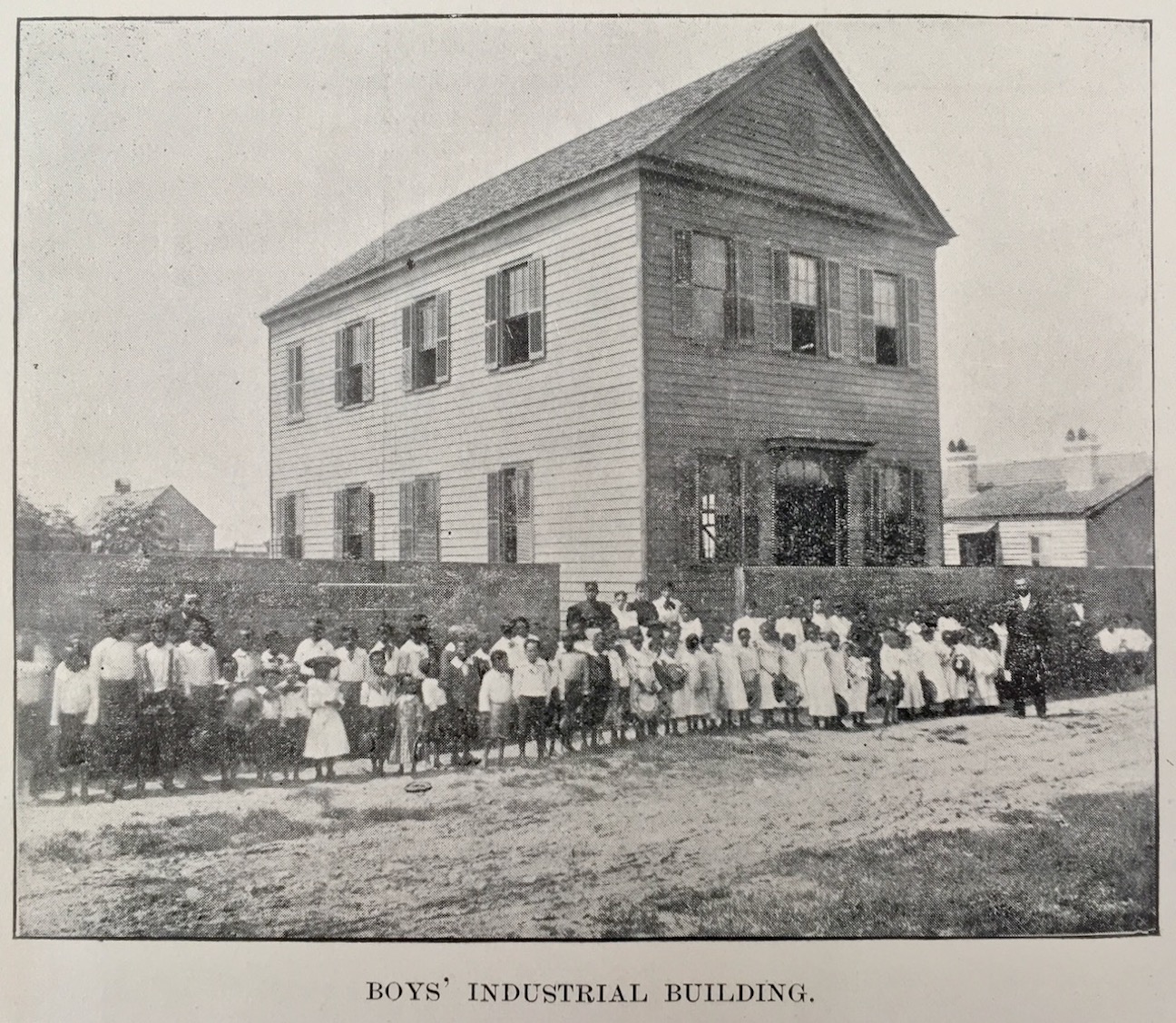
After several years of continuous fund raising, including fruitless petitions to the city board of school commissioners, John Dart and his associates secured sufficient private funds to construct a larger school building at the southwest corner of Bogard and Kracke Streets. The ceremonial laying of its cornerstone took place on 10 May 1898 before a crowd that included local and visiting dignitaries.[18] Eighteen months later, on Thanksgiving Day 1899, crowds returned to witness the dedication of the new building of what was then called the Charleston Industrial School for Colored Children.[19] The large, nearly-square, two-story wooden structure was ostensibly devoted to the vocational education of young girls, but the building also hosted offices and a large auditorium.
The Charleston Normal and Industrial Institute, as it became known at the turn of the twentieth century, flourished at the dawn of a new era. While success and progress attended Dart’s enterprise on Kracke Street, discord erupted again at the Morris Street Baptist Church in May 1902. A large portion of the congregation, perhaps a majority, voted to dismiss Rev. Dart from the pastorate, but he refused to leave. Heated confrontations at the sanctuary inspired the chief of police to close the church to both factions in June 1902 in order to keep the peace. For the next year and a half, two groups identifying themselves as Morris Street Baptist Church held separate services at different locations—the faction backing Rev. Dart worshiping at the auditorium of his Industrial School on Kracke Street.
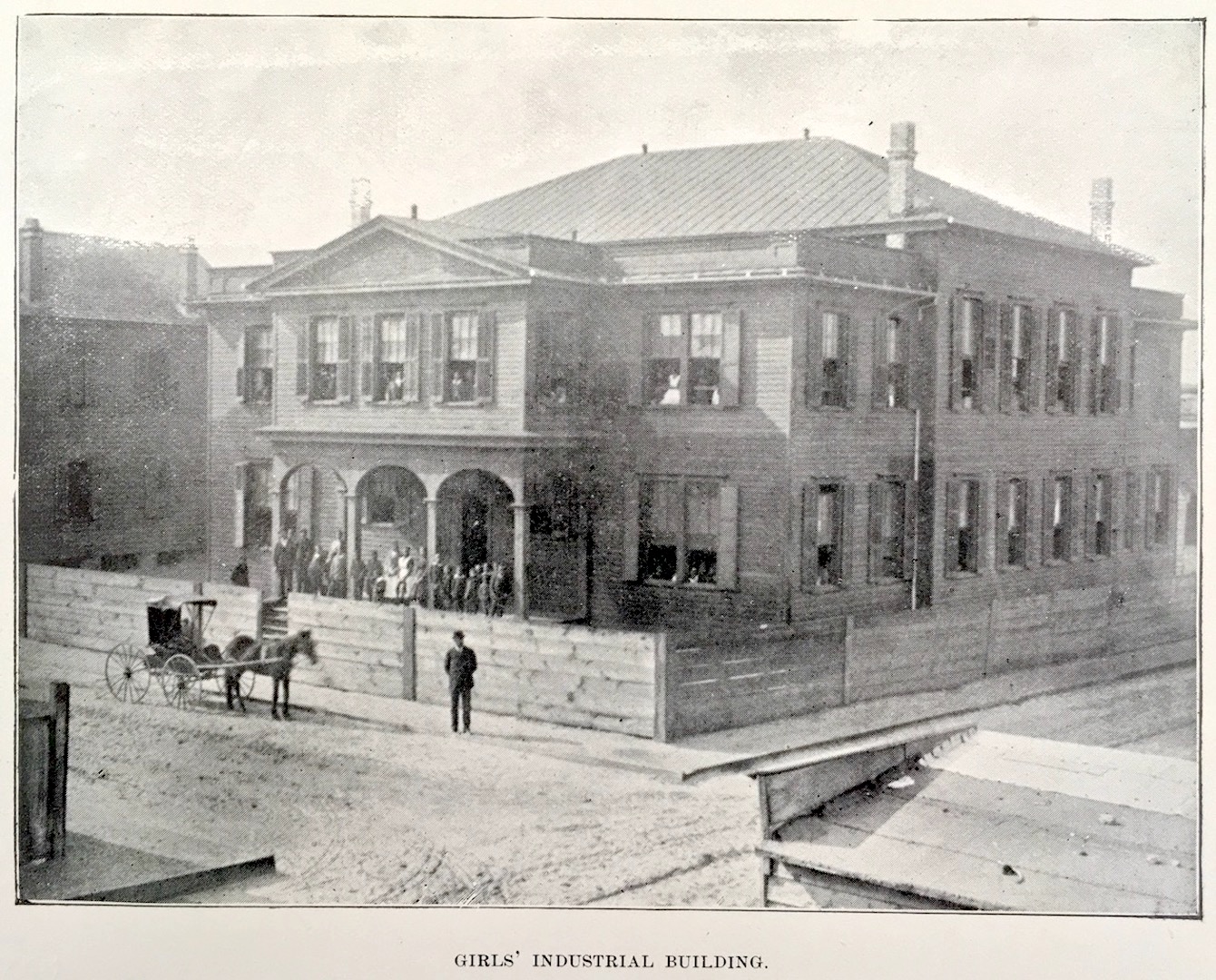
At the same time, Dart was also in court facing a charge of fraud leveled by members of the nearby Calvary Baptist Church. Although he successfully defended his reputation in the convoluted Calvary case, the South Carolina Supreme Court ruled in late October 1903 that the Morris Street Baptist Church had legitimately dismissed Dart some seventeen months earlier.[20] The controversial pastor thereafter conceded the end of his sixteen-year tenure at his father’s church. Six weeks later, in December 1903, he accepted the call to lead a newly-organized congregation called Shiloh Baptist Church, located on the east side of Smith Street, slightly north of Morris Street (now the site of Shiloh Park, created in 2022).[21]
The dawn of 1904 inaugurated a period of relative calm for Rev. Dart, but soon his long-standing rivalry with Rev. Daniel Jenkins, the “Orphanage Man,” came to a head. The two Baptist ministers, men of roughly the same age but from very different backgrounds, were cordial to each other in public, but privately jealous and contemptuous of each other’s work. In March 1904, they used the pages of a local newspaper to trade polite insults, perhaps followed by coarser words exchanged in private.[22] A Dart essay deriding Jenkins, published in Dart’s own newspaper, the Charleston Reporter, in January 1906, prompted the Orphanage Man to file suit for “malicious libel” that May, alleging damages in the amount of $20,000. The case came to trial in March 1907, but apparently dissolved without consequence.[23]

During the early days of 1908, the commissioners of Charleston’s municipal school board moved forward with plans to build a new school for white children in the upper wards, and simultaneously signaled their willingness to construct a similar building as an industrial school for “colored” children.[24] The main obstacle, in the opinion of the city’s white administrators, was funding. They had spent the bulk of their state-appropriated funds on the new school for white children, which became Mitchell Elementary at the southeast corner of Perry and Fishburne Streets. On 6 May 1908, John Dart and a small delegation of Black ministers visited the board room of Charleston’s municipal school commissioners. After being invited to speak, Rev. Dart read aloud a petition that must have been familiar to the all-white board. He first reiterated the “great and crying need of increased public school accommodations for the colored children of this city, many of whom are now roaming the streets and growing up in ignorance, idleness and crime since they are shut out from the two overcrowded colored public schools.” On behalf of his colleagues, however, Dart said “we do hail with delight and gratitude the purpose and plan of your board to provide additional school facilities for the colored children,” urging the board to focus on vocational training and to allow Black teachers to apply for jobs instructing Black pupils in the city’s public schools.[25]
Although the City of Charleston refused to employ Black teachers in its public schools until 1922, the municipal school board secured pledges for a total of $13,000 from several Northern sources by the end of 1908, and appropriated $10,000 of its own budget for the construction of a public industrial school for African-American children.[26] Students at Dart’s own private institution were then midway through the school’s fifteen year, which would prove to be the high-water mark of the principal’s career. On the afternoon of 19 March 1909, Dart welcomed a distinguished visitor who might have inspired his long commitment to industrial education. Booker T. Washington (1856–1915), the driving force behind the prestigious Tuskegee Institute in Alabama since the 1880s, had visited Charleston a decade earlier and visited Rev. Dart’s school. His return in the spring of 1909 with words of encouragement capped a long series of accomplishments at the corner of Kracke and Bogard Streets.[27]
On the last day of May 1909, Rev. Dart addressed his pupils and their parents at the fifteenth annual closing exercises of the Charleston Normal and Industrial Institute. The theme of his remarks was amply familiar to the audience. “Book learning” was “not enough,” he told the crowd, as he had on numerous previous occasions. “The small amount of elementary education that our negro children are receiving in the public schools here finds lodgment in the head and is never turned to practical account—it never reaches the hands of the boys and girls.” “Industrial education and manual training in the public schools” was, in Dart’s opinion, “a great and long felt need of the educational system of this city.” The reverend principal then alluded to the plan then underway to build a large public school building to provide vocational training to the African-American children of Charleston’s upper wards:
“But it is gratifying to many to know that preparation is now being made to teach our boys and girls in the schools to do and make things with their hands, as well as to give them book learning. The young people who are being constantly sent out by our schools to engage in the practical duties of life should have such industrial training as will fit them to do good and useful work, whether in the home, in the workshop or on the farm, and will enable them to obtain an honorable livelihood. The establishment in this city of a well-equipped manual training school, where negro boys and girls made acquire a knowledge of tools, useful handicrafts and the household arts would be a great blessing to the colored population here.”[28]
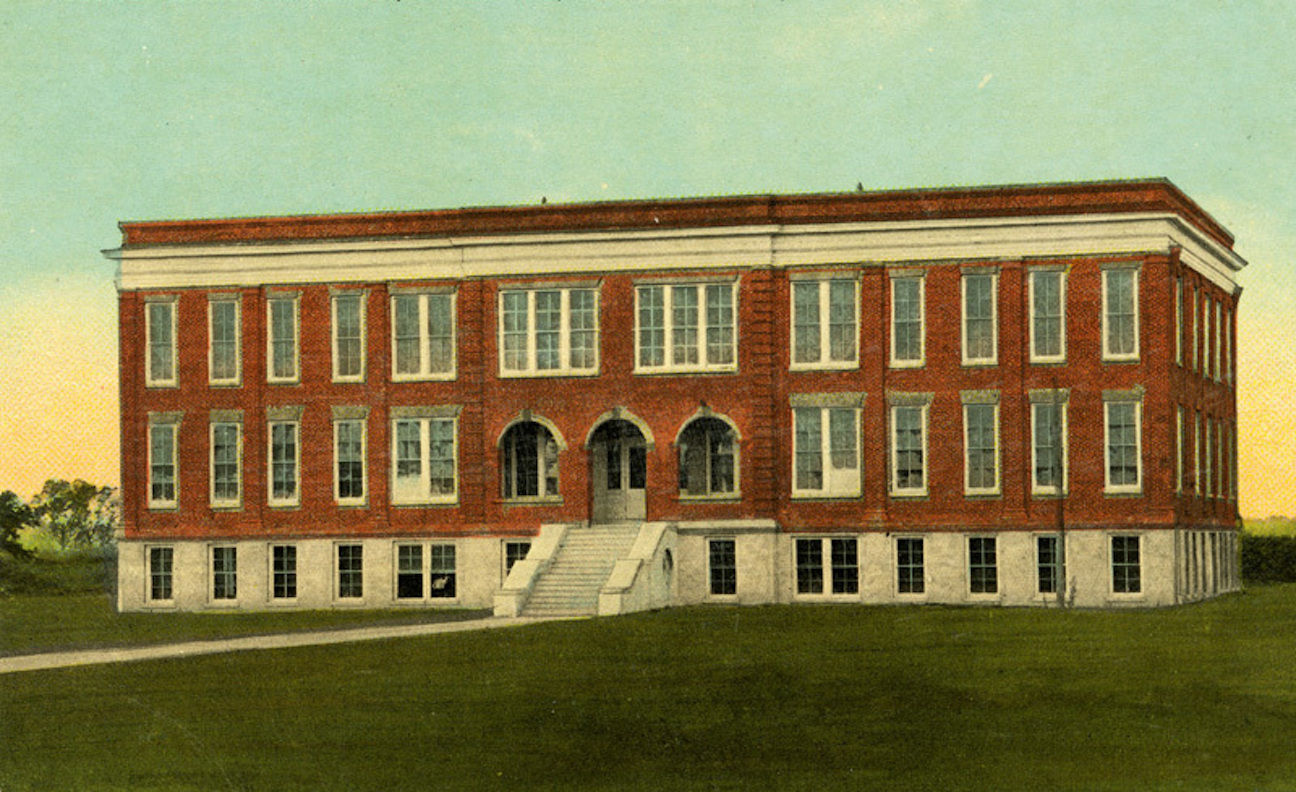
John Dart did not articulate in May 1909 how the rise of a public industrial school in Charleston would impact the future of the institution he had long nurtured, but change was inevitable. His private school, which had grown significantly over a period of more than twenty years, was funded entirely by donations from generous benefactors, most of whom resided in the Northern states. Similarly, the city’s plan to build an industrial school for “colored children” was predicated on the promise of large donations from Northern sources—money that arrived in early 1909. Dart must have recognized that their shared philanthropic sources would likely henceforth refuse to fund duplicate institutions within the same community. Deprived of outside financial support, the venerable Dart school was about to become redundant.
During the month of June 1909, the City of Charleston’s public school commissioners secured a six-acre site for their proposed “Colored Industrial School” at the northwest corner of President and Fishburne Streets and approved plans for a large, three-story brick building designed by local architects, Todd and Benson.[29] As the long-desired public vocational school moved from the drawing board to the construction site during subsequent months, John Dart’s own school quietly faded from the local landscape. I can find no evidence that Dart’s Industrial School at the corner of Kracke and Bogard Streets opened in the autumn of 1909, nor any notice that the reverend presided over closing exercises in the late spring of 1910, as he had done for the previous two decades. It appears, therefore, that the forward momentum of the city’s public industrial school overshadowed the peaceful demise of Rev. Dart’s private institution.
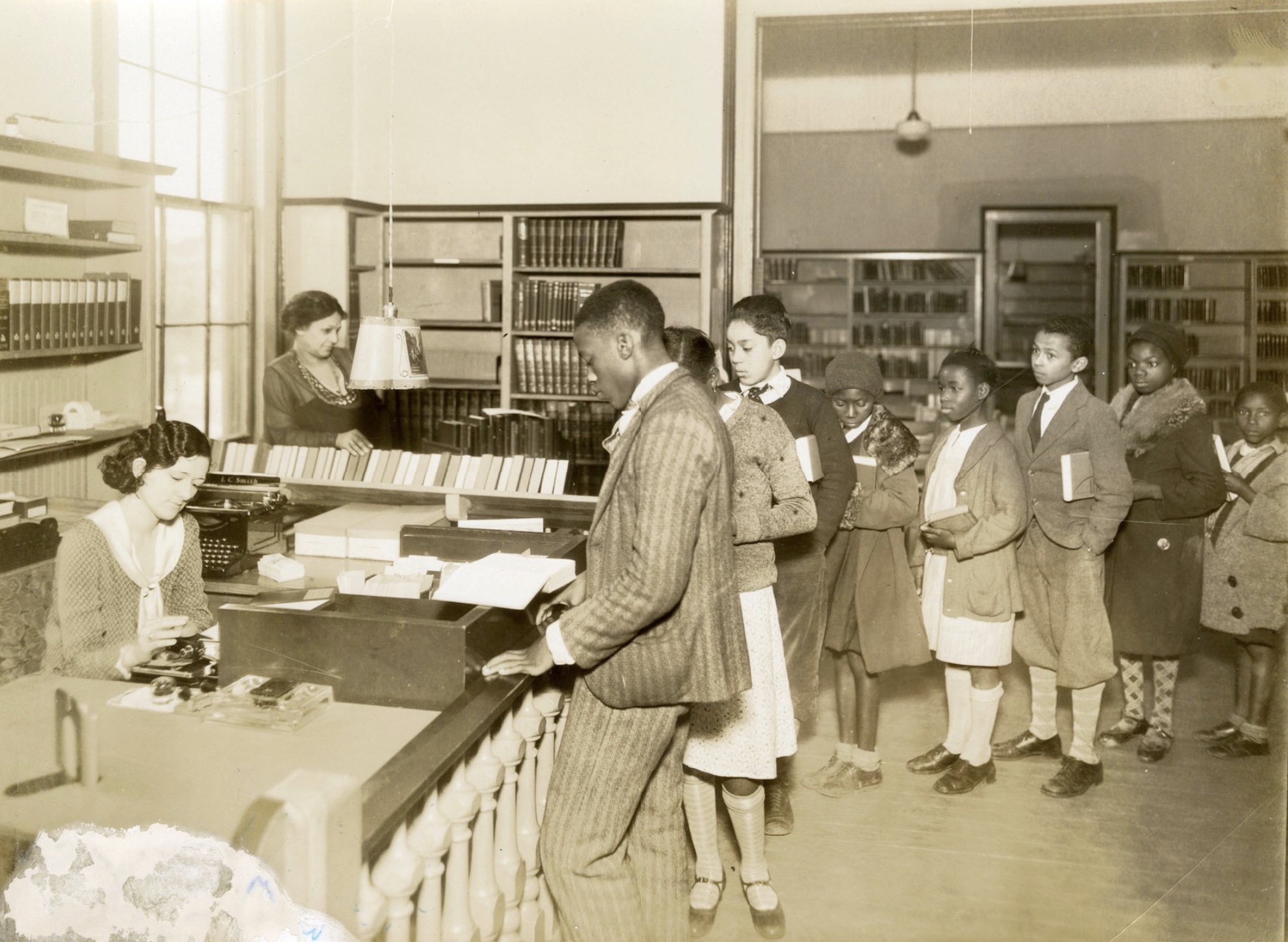
The City of Charleston’s Colored Industrial School opened unofficially in the autumn of 1910, before the building’s plumbing works had been completed, and officially opened in January 1911 with nearly four hundred students. None of the newspaper coverage surrounding the school’s construction or opening mentioned Rev. Dart or his venerable industrial school.[30] Dart’s Hall, as the facility became known after 1910, continued to serve as a meeting place and business incubator for Black residents of the upper wards, but the building’s educational legacy quietly faded from local memory. When the City of Charleston renamed its public industrial school for African-American children in 1921, it honored James E. Burke, a long-serving white member of the municipal school board, rather than John Dart or any other Black educator in the community.[31]
Declining health might have constrained Dart’s professional life as he approached the sixtieth year of his age, but he persevered along a familiar path. His ten-year relationship with Shiloh Baptist Church on Smith Street ended quietly sometime during the summer or early autumn of 1913, before that church was reorganized as Shiloh Union Methodist Episcopal Church.[32] During the next two years, Dart remained active in the community, helping to raise money for the Red Cross and for the local nurses’ school, participating in the annual celebrations of Emancipation Day, and campaigning for the Black branch of the Charleston YMCA.[33] He traveled to New York with his family in the summer of 1915, perhaps for the recovery of his health, but died at Saratoga Springs on July 17th at the age of 61. The Dart family shipped his remains back to Charleston, and he was buried later the same month at the Unity and Friendship Society Cemetery on Cunnington Street.

After the reverend’s death, his family engaged a young African-American artist, William Edouard Scott (1884–1964), to produce a large portrait of John Dart. That distinguished likeness dated 1917 might have hung in the reverend’s former office at Dart Hall, where his extensive personal library remained on the shelves. A decade later, in the autumn of 1927, Dart’s eldest daughter, Susan, transformed her father’s literary collection into Charleston’s first lending library for Black residents (see Episode No. 43). Dart Hall Library, as it was known for four decades, became the principal “Negro branch” of Charleston County’s publicly-funded but segregated Free Library system in 1931.
A modern, racially-integrated building replaced the aging Dart Hall Library in December 1968, but the name and other family heirlooms transferred to the new facility. The John L. Dart Library at 1067 King Street, reopened in January 2024 after an extensive refurbishment, welcomes visitors of all ages to browse the shelves, surf the Internet, study, relax, and hear inspirational programs. Handsome portraits of Rev. Dart and Susan Dart Butler, prominently displayed near the entrance, remind twenty-first century citizens of the industrious figures of generations past who toiled to secure the rights and amenities that we too often take for granted.
[1] Francis Sires to William Dart, conveyance of Lot Q 56 in the subdivision of the estate of the Rev. William Percy, 17 January 1852 [sic; 1853], Charleston County Register of Deeds (hereafter CCRD), book X12: 221; William Dart to Francis Sires, mortgage, 17 January 1853, CCRD W12: 477. For an illustration of this lot, see Plat No. 6707 in the John McCrady Plat Collection, CCRD. The lot in question is now identified as 258 Coming Street.
[2] Charleston Courier, 20 June 1865, page 2, “Ecclesiastical”; Courier, 28 June 1865, page 2, “At an adjourned meeting of the members of the Morris-street Baptist Church”; William Dart, et al., to John S. Riggs, mortgage of property on the south side of Morris Street, between St. Philip Street and Coming Street, 19 July 1865, CCRD A14 No. 5, pages 264–66; 21 April 1870: William Dart, Jacob Legare, et al., “Agreement for the purposes of incorporation,” 21 April 1870, CCRD F17: 4–5.
[3] A. B. Caldwell, ed., History of the American Negro. South Carolina Edition (Atlanta: A. B. Caldwell Publishing Co., 1919), 210–12. For additional details of Dart’s life and career, see the “John L. Dart family papers,” collection AMN 1069, at the Avery Research Center for African American History and Culture at the College of Charleston.
[4] Charleston News and Courier (hereafter CNC), 29 July 1893, page 8, “Industrial Training. The Model School of the Morris Street Colored Baptist Church.”
[5] See CNC, 4 June 1889, page 8, “All About Baptism”; CNC, 8 June 1889, page 8, “The Challenge Accepted”; CNC, 10 June 1889, page 8, “The Methods of Baptism.”
[6] CNC, 16 October 1890, page 8, “Want To Excommunicate Him”; CNC, 17 October 1890, page 8, “The Colored Baptist War”; CNC, 22 October 1890, page 8, “Dart and Anti-Dart”; CNC, 28 October 1890, page 2, “A Baptist Manifesto”; CNC, 21 January 1891, page 8, “To Be Fought In Court”; CNC, 10 February 1891, page 2, “Dart and Anti-Dart.”
[7] CNC, 28 September 1891, page 8, “Religious Kickers”; CNC, 19 November 1891, page 8, “The Baptist Brethren”; CNC, 21 November 1891, page 8, “Let Us Have Peace.”
[8] CNC, 20 November 1892, page 8, “Assaulted His Pastor”; CNC, 28 November 1892, page 2, “Arrested in Church”; CNC, 4 February 1893, page 8, “Dart and his Deacons.”
[9] CNC, 6 April 1893, page 8, “What Shall We Do With It? The Thomson Bequest to the City and Its Disposition.”
[10] CNC, 5 April 1893, page 5, “The Slater Fund”; CNC, 11 April 1893, pages 4 and 8, “The Chance for Charleston”; CNC, 12 April 1893 (Wednesday), page 2, “For a Colored School”; CNC, 12 April 1893, pages 1 and 4: “The Slater Fund” and “The Slater Industrial School.”
[11] CNC, 9 March 1893, page 8, “The Colored Orphanage”; CNC, 16 September 1893, page 8, “A Worthy Charity. Opening of a Negro Orphanage In Franklin Street.”
[12] CNC, 26 October 1893, page 2, “The Gospel of Manual Labor.”
[13] CNC, 29 November 1893, page 12, “A Good Project. The Effort to Establish a Manual Training School for Negro Boys and Girls”; CNC, 13 December 1893, page 8, “An Industrial School Fair”; CNC, 23 March 1894, page 8, “A Praiseworthy Undertaking.”
[14] CNC, 1 June 1894, page 8, “Colored Industrial School”; CNC, 21 July 1894, page 2, “Industrial Education”; CNC, 25 September 1894, page 2, “A New Departure”; CNC, 29 November 1894, page 12, “The Colored Industrial School.”
[15] CNC, 11 June 1895, page 8, “The Only One of the Kind.”
[16] CNC, 28 May 1896, page 5, “To Make Them Self-Supporting.”
[17] CNC, 8 June 1897, page 8, “Rev. J. L. Dart’s School.”
[18] CEP, 11 May 1898, page 4, “Industrial School For Colored Children Laid Yesterday.”
[19] CNC, 6 December 1899, page 3, “‘Our Duty To The Negro.’”
[20] CEP, 26 October 1903, page 1, “Dart Loses On Appeal”; CEP, 15 March 1904, page 2, “Calvary Church Loses”; News and Courier, 16 March 1904, pages 1–2, “The Rev. J. L. Dart Wins Out.” Dart sued the Morris Street Baptist Church in 1904 for arrears of salary and in 1905 recovered part of the sum requested; see CNC, 28 September 1904, page 3, “Minister Sues for Salary”; CNC, 30 March 1905, page 7, “Preacher Gets His Salary.”
[21] CNC, 8 December 1903, page 3, “Shiloh Baptist Church.”
[22] CEP, 5 March 1904, page 3, “Rev. Dart on Rev. Jenkins”; CEP, 10 March 1904, page 2, “Rev. Jenkins To Rev. Dart.”
[23] Charleston Evening Post (hereafter CEP), 21 May 1906, page 1, “Jenkins Sues Dart”; CNC, 22 May 1906, page 5, “Asks $20,000 Damages”; CEP, 11 March 1907, page 1, “Judgment in 12 Cases.” No further information about this libel suit can be found.
[24] See, for example, the inaugural remarks of Mayor R. G. Rhett in CEP, 16 December 1907, page 2, “Mayor Rhett In Inaugural Tells Where To Improve.”
[25] See the minutes of the City Board of Public School Commissioners, 6 May 1908, in the “Records of the City Board of Public School Commissioners, 1812–1935,” Charleston Archive, Charleston County Public Library.
[26] See the minutes of the City Board of Public School Commissioners, 21 May, 3 June, and 13 November 1908, and 6 January 1909, at CCPL
[27] CNC, 19 March 1909, page 10, “Booker Washington Here”; CNC, 20 March 1909, page 5, “Booker Washington Here.”
[28] CNC, 1 June 1909, page 9, “Book Learning Not Enough.”
[29] See the minutes of the City Board of Public School Commissioners, 14 June and 25 June 1909, at CCPL.
[30] CEP, 26 August 1910, page 2, “The Industrial School”; CNC, 16 October 1910, page 26, “Opening of School Delayed”; CNC, 11 November 1910, page 1, “School Children of City Addressed by President [Taft]”; CEP, 6 February 1911, page 5, “Colored Industrial Schools”; CNC, 7 February 1911, page 7, “Colored Industrial School In Operation.”
[31] For an overview of this institution’s history, see Sherman E. Pyatt, Burke High School, 1894–2006 (Charleston, S.C.: Arcadia Press, 2007).
[32] Dart was identified as the pastor of “Shiloh Church” in CEP, 11 April 1913, page 13, “For Flood Sufferers,” but that Smith Street church was identified as part of the newly-incorporated Union Methodist Episcopal Church in the funeral notices of Minnie Cantey in CEP, 1 November 1913, page 15.
[33] CEP, 11 April 1913, page 13, “For Flood Sufferers”; CNC, 2 January 1914, page 2, “Celebrated Emancipation”; CNC, 10 April 1914, page 10, “Recital and Assembly”; CNC, 19 April 1914, page 18, “Monster Mass Meeting”; CNC, 18 January 1915, page 6 , “Board of Management.”
NEXT: Segregation and Desegregation at the Charleston County Public Library, 1930–1965
PREVIOUSLY: The Beef Market under Charleston's City Hall
See more from Charleston Time Machine
